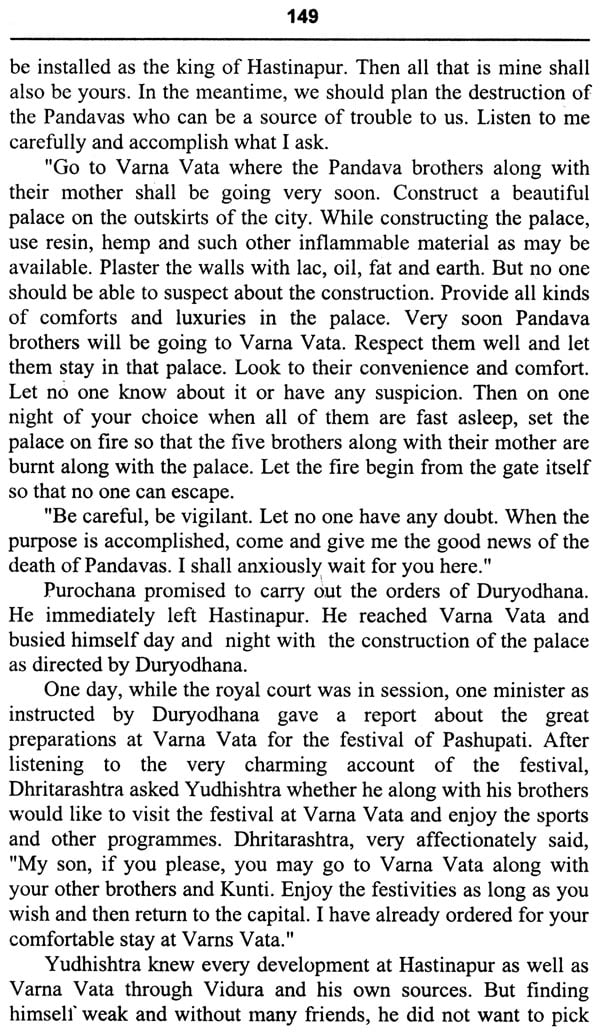
Stories From Mahabharata
Book Specification
| Item Code: | NAR196 |
| Author: | Dr. S.N. Sharma |
| Publisher: | Parimal Publication Pvt. Ltd. |
| Language: | English |
| Edition: | 2014 |
| ISBN: | 9788171102167 |
| Pages: | 163 |
| Cover: | HARDCOVER |
| Other Details | 8.50 X 5.50 inch |
| Weight | 300 gm |
Book Description
India has a very ancient tradition of stories. There are a number of short legends in Brahman; Upanishads and Nirukta. Ramayan and Mahabharat contain many stories. Brihad Devata is the oldest existing collection of Vedic legends. Katha Sarit Sagar, Pancha Tantra and Hitopadesh belong to a later period of good Indian stories.
The Mahabharat is a mine of stories. There are hundreds of stories some of which are the finest specimen of short stories eg. Usinara and the Pigeon, Satyavan-Savitri, Nal-Damyanti etc. The Mahabharat depicts the post Vedic society with all its characteristics. Some of the descriptions appear to us today somewhat strange. But they were perhaps relished during those times. Religion seemed to dominate all aspects of life- social, political and economic. The stories have a tendency to point towards the need for moral behaviour. There is great importance of Yajna, Mantras and asceticism. They are believed to result in great merit and even amazing spiritual power. The whole world seemed to be afraid of a curse of an ascetic. Apart from Brahma, Vishnu and Mahesh, a number of other lesser gods like Kuber, the god of wealth, Ganesh, the god of learning, Karttikeya, the god of war, Laxmi, the goddess of wealth, and Durga, the goddess of destroyer of the wicked frequently appear on the stage.
There are frequent references to heaven and hell, Devas and Asuras. There are travels between heaven and earth by humans and celestials. Also human beings possess the competence to transform themselves into animals, birds and even stones. There are hints that physical union of man and woman was not necessary for procreation. Birth of humans was possible_ through the union of spiritual bodies of the two. There are also references to growing at will and even control aging. Then, there are exaggerations in terms of time and size. Living for a thousand years, an elephant of ten yojana etc. are quite common. The world-weariness, transmigration, incarnation, varnashrama-based social order, and other beliefs of the Bhagwata cult are frequently referred to. Thus the Mahabharat is an epic of a different age. Sometimes, it becomes difficult to have a real feel of the social and physical background. "To understand it thoroughly, the reader must have seen the tropical plains and forests of Hindustan steeped in intense sunshine or bathed in brilliant moonlight, he must have viewed the silent ascetic seated at the foot of the sacred fig tree, he must have experienced the feeling inspired by the approach of the monsoon, he must have watched beasts and birds disporting themselves in tank and river; he must know the varying aspects of nature in the different seasons. In order to give a feel of that ancient environment, some Sanskrit words have been used. A list of such words is given at the end in a Glossary.
The author of the Mahabharat is believed to be Veda Vyas, the son of Rishi Parashar and Satyavati. Veda Vyas was also the arranger of the four Vedas and other scriptures of the Vedic age. The occasion of narrating the story of the Mahabharat is the performance of a Snake-Sacrifice organised by the Kuru King Janmejay to avenge the tragic death of his father. At that time, many Rishies and learned people had gathered there and they wanted to listen to the stories of the Kuru race. The narrator is the great disciple of Veda Vyas, Rishi Vaishampayan. The saints eagerly ask Vaishampayan to relate some interesting stories. Vaishanpayan takes delight in narrating the stories as he had heard them from his preceptor-Veda Vyas.
The stories in this book are from the Adi Parva or the first chapter of the Mahabharata. The stories have been pieced together from the narratives as they are unfolded from chapter to chapter. Almost no change has been made in the main events of the stories; but the sequence has sometimes been changed for more effective presentation. The language used has been simple and straightforward for the sake of easy comprehension. The stories are designed to inform and eatertain the reader.
**Contents and Sample Pages**












